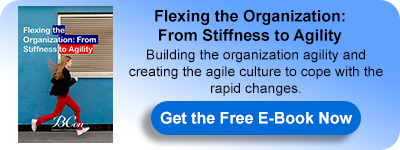What is Organization Agility?
Before we head into agility and its definition, we need to differentiate between adapting and being adaptable in an organization. That's a core issue when talking about agility.
When they go through changes that most organizations have been going through in response to COVID19 for example, have been changes specifically designed to adapt. That's a lot different than thinking about adaptability and building an organization that can change over and over as if it were routine. When COVID 19 hit, a lot of organizations were agile by necessity. However, when we are talking about the paradigm of agile organizations, we are targeting agility by design, intentionally building an organization that changes and adapts systematically whenever anything comes around.
Too often, organizations think about adapting instead of how to become adaptable.
- Agility represents such capability
- Agility is about adapting and innovating over and over again, and no organization can be called agile unless it can demonstrate the ability to change repeatedly
- Agile organizations see digitization as a one-in-a-series of adaptations
Hence, Christ Worley defined agility as: "The ability to make timely, effective, and sustained organizational changes when and where it results in a performance advantage."
Why is Agility Important for Today's Organizations?
Everyone is talking about agility these days—a Google search for "agile transformation" yields about 100 million results, and well-known pioneers' experiences are widely shared. Is this, however, just marketing hype, or are there real benefits to be had? Is agility just noise from the IT department, or is it a real opportunity that the executive leadership should be paying attention to?2
It is clear that today's markets and economic systems are prone to substantial destabilizing or disruptive shifts and, above all, have grown significantly more complicated. In this case, traditional resource optimization may possibly be harmful.
Companies that have been designed to operate in a stable environment are unlikely to be resilient or adaptable to disruptive events. They, like tankers, take a long time to reorient themselves. Furthermore, inadvertent bias obstructs their view: you don't see what you don't expect. Companies that are flexible and inventive grasp the chance and target the old front runners – the dinosaurs — who are entirely unaware that they are being assaulted. And by the time they realize what's going on, it'll be too late. 3
First, let's discuss the forces pushing organizations towards adopting a more agile framework.
According to McKinsey & Company, the digital revolution is posing four challenges to companies, economies, and societies: 4
1. A Rapidly Changing Environment
The needs of stakeholders are shifting. Customers, partners, and regulators all have immediate requirements. Investors are looking for more growth. Competitors and colleagues expect you to respond quickly to shifting priorities.
2. Disruptive Technology is Constantly Being Introduced
Digitization is displacing businesses and sectors. AR and VR, machine learning, chatbots, messaging platforms, AI, and other disruptive technologies and new modes of communication are examples.
3. Increasing the Rate of Information Digitization and Democratization
The volume, transparency, and distribution of information have expanded, requiring firms to engage in rapid multidirectional communication and sophisticated cooperation with customers, partners, and colleagues.
4. Recruiting and Keeping Top Performers
Attracting and retaining excellent personnel is becoming more difficult for brands and businesses. Diversity, new interviewing techniques, data, and artificial intelligence are four recruiting trends that firms must consider when putting their hiring processes into action.
Hence, organizations must increase their change agility not merely to succeed but to live in this world of rapid, concurrent, and never-ending change. In fact, senior executives are beginning to see how critical agility is to their success. According to a PwC poll of 1150 CEOs, 76% believe their ability to adapt to change will be a crucial source of competitive advantage in the future. According to a McKinsey study, organizational agility is vital to corporate success for 9 out of 10 leaders, and it is becoming more critical over time. Therefore, organizations and leaders need to look at the benefits of adopting a more agile approach to reap the benefits. 5
1Quality & Equality, Accessed 15 April 2022, What is Organizational Agility: A Conversation with Chris Worley https://www.youtube.com/watch?v=3kuMESQUl2U
2 Mckinsey and Company, 25 May 2021, Wouter Aghina, Christopher Handscomb, Olli Salo, and Shail Thaker, The impact of agility: How to shape your organization to compete, Accessed 14 April 2022, https://www.mckinsey.com/business-functions/people-and-organizational-performance/our-insights/the-impact-of-agility-how-to-shape-your-organization-to-compete
3Forbes, 4 Feb 2021, Michael Thiemann, Why Is Agility So Important To The Success Of Companies?, Accessed 14 Apr 2022, https://www.forbes.com/sites/forbescoachescouncil/2021/02/04/why-is-agility-so-important-to-the-success-of-companies/?sh=2423d7f76f29
4Brand Minds, 4 Sep 2018, IULIA-CRISTINA UȚĂ, 22 Benefits of the Agile Organisation, Accessed 14 April 2022, https://brandminds.live/22-benefits-of-the-agile-organisation/
5Prosci, Accessed 14 Apr 2022, https://www.prosci.com/resources/articles/organizational-agility-strategic-imperative
For more about this topic, download our latest book " Flexing the Organization: From Stiffness to Agility " for FREE:
